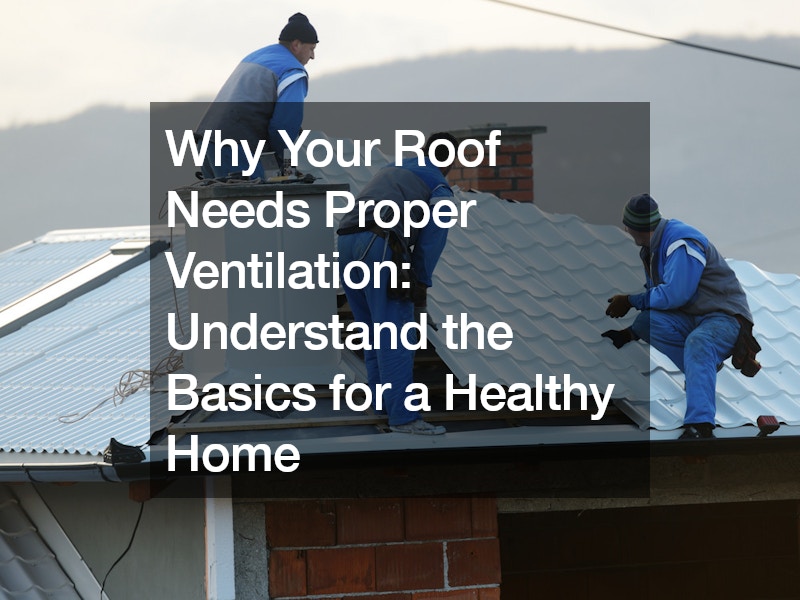When it comes to your home, there’s more to your roof than just shingles and tiles. Proper ventilation plays a crucial role in maintaining the health and longevity of your roof, as well as the overall well-being of your home. In this article, we’ll delve into the basics of roof ventilation and why it’s essential for a healthy living environment.
First and foremost, let’s address the question: What exactly is roof ventilation? In simple terms, roof ventilation refers to the movement of air in and out of the attic space beneath your roof. This airflow helps regulate temperature and moisture levels, preventing issues such as mold, mildew, and premature deterioration of roofing materials.
So, why is proper ventilation so important? Well, imagine your attic as a giant storage closet tucked away above your living space. Without proper ventilation, this space can quickly become a breeding ground for problems. Here are some key reasons why your roof needs proper ventilation:
- Extended Roof Lifespan: Just like how fresh air keeps us feeling healthy and energized, proper ventilation extends the lifespan of your roof. Without it, trapped heat and moisture can cause roofing materials to deteriorate prematurely, leading to costly repairs or even the need for a full roof replacement.
- Energy Efficiency: Did you know that your attic’s temperature can significantly impact your home’s energy bills? In the summer months, a hot and stuffy attic can cause your air conditioning system to work overtime, driving up your energy costs. Proper ventilation helps expel excess heat, keeping your attic and home cooler and more comfortable.
- Prevention of Moisture Issues: Moisture is the enemy of any home, leading to mold, mildew, and structural damage over time. Proper ventilation allows moisture to escape, preventing condensation buildup and safeguarding your home against these issues.
- Reduced Maintenance Costs: A well-ventilated roof means fewer headaches and expenses down the road. With proper airflow, you’re less likely to encounter leaks, water damage, or other maintenance issues that can arise from a poorly ventilated attic.
Now that we understand the importance of roof ventilation, let’s explore some common ventilation options available for homeowners:
- Box Vents: These traditional vents, often seen as small squares or rectangles on the roof, allow hot air to escape through natural convection. While they’re a common and cost-effective option, they can be prone to rust and leaks if not installed correctly.
- Whirlybirds: Also known as turbine vents, these vents spin to create airflow and are more effective than box vents. However, cheaper models may generate noise and require maintenance over time.
- Power Vents: These vents feature fans powered by electricity or solar energy to enhance ventilation. While they can be effective, some experts question their long-term efficiency and potential to draw conditioned air from inside the home.
- Ridge Vents: Considered one of the best options for roof ventilation, ridge vents are installed along the peak of the roof to allow hot air to escape naturally. Unlike other vents, ridge vents are less likely to leak and provide consistent airflow throughout the attic space.
In addition to these ventilation options, it’s essential to consider other factors such as skylights. While skylights add natural light and aesthetic appeal to your home, they can also impact ventilation. Properly positioning skylights can enhance airflow and contribute to a well-ventilated attic space.
Common Signs of Poor Roof Ventilation
Recognizing signs of poor roof ventilation is crucial for homeowners to address potential issues before they escalate. Musty odors, mold growth, or water stains in the attic may indicate excessive moisture buildup, a common consequence of inadequate ventilation. Excessive heat in the attic during summer months can lead to warped or damaged roofing materials and increased energy bills. Additionally, ice dams forming along the roof edge in winter may signal poor ventilation and insulation, risking water damage to the interior of the home. Regular inspection and maintenance of attic ventilation systems can help identify and rectify these warning signs, preserving the integrity of the roof and ensuring a healthy indoor environment.
DIY Roof Ventilation Tips
Maintaining proper roof ventilation doesn’t have to be daunting. With a few simple steps, homeowners can ensure their attic stays well-ventilated year-round. Start by inspecting existing vents for debris or damage and clean or repair them as needed. Consider installing additional vents if airflow seems insufficient. Seal any gaps or cracks in the attic to prevent air leakage, and check insulation levels to ensure they meet recommended standards. Regularly monitor attic temperature and humidity levels to gauge ventilation effectiveness. By taking proactive measures and staying vigilant, homeowners can protect their roofs and maintain a healthy indoor environment.
In conclusion, proper roof ventilation is essential for maintaining a healthy and efficient home. By understanding the basics of ventilation and choosing the right system for your roof, you can ensure longevity, energy efficiency, and peace of mind for years to come. So, don’t overlook the importance of ventilation—your roof and your home will thank you for it.
.

